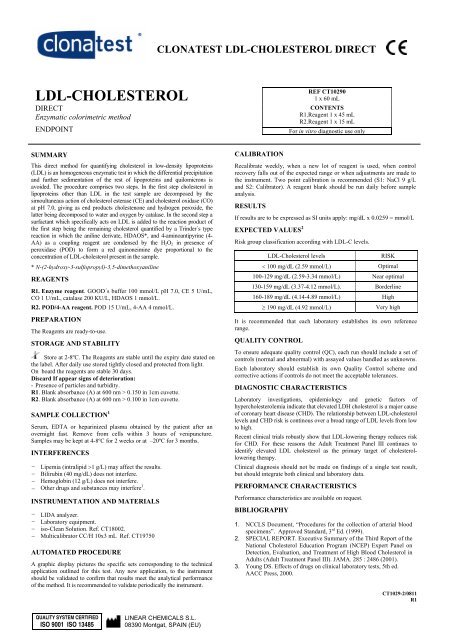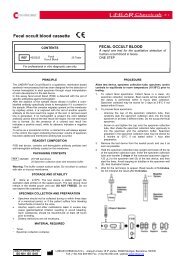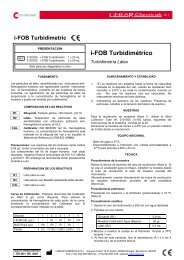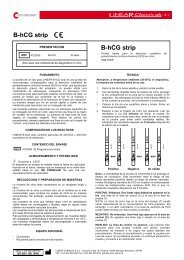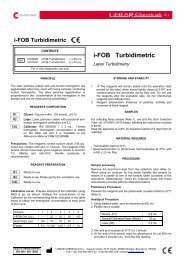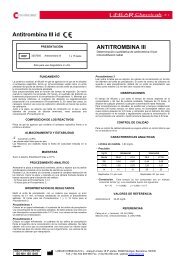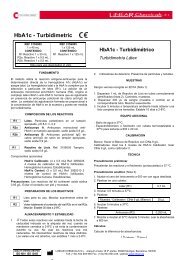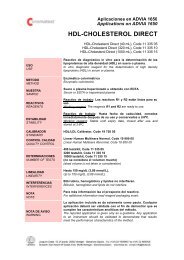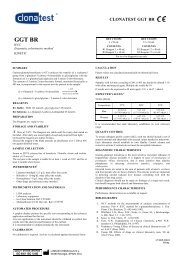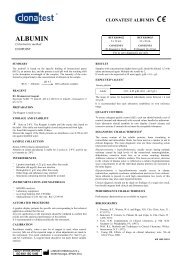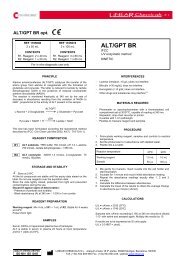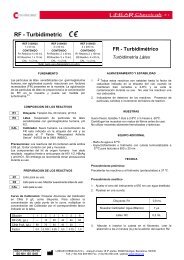LDL-CHOLESTEROL - LINEAR CHEMICALS
LDL-CHOLESTEROL - LINEAR CHEMICALS
LDL-CHOLESTEROL - LINEAR CHEMICALS
Create successful ePaper yourself
Turn your PDF publications into a flip-book with our unique Google optimized e-Paper software.
CLONATEST <strong>LDL</strong>-<strong>CHOLESTEROL</strong> DIRECT<br />
<strong>LDL</strong>-<strong>CHOLESTEROL</strong><br />
DIRECT<br />
Enzymatic colorimetric method<br />
ENDPOINT<br />
REF CT10290<br />
1 x 60 mL<br />
CONTENTS<br />
R1.Reagent 1 x 45 mL<br />
R2.Reagent 1 x 15 mL<br />
For in vitro diagnostic use only<br />
SUMMARY<br />
This direct method for quantifying cholesterol in low-density lipoproteins<br />
(<strong>LDL</strong>) is an homogeneous enzymatic test in which the differential precipitation<br />
and further sedimentation of the rest of lipoproteins and quilomicrons is<br />
avoided. The procedure comprises two steps. In the first step cholesterol in<br />
lipoproteins other than <strong>LDL</strong> in the test sample are decomposed by the<br />
simoultaneaus action of cholesterol esterase (CE) and cholesterol oxidase (CO)<br />
at pH 7.0, giving as end products cholestenone and hydrogen peroxide, the<br />
latter being decomposed to water and oxygen by catalase. In the second step a<br />
surfactant which specifically acts on <strong>LDL</strong> is added to the reaction product of<br />
the first step being the remaining cholesterol quantified by a Trinder´s type<br />
reaction in which the aniline derivate, HDAOS*, and 4-aminoantipyrine (4-<br />
AA) as a coupling reagent are condensed by the H 2 O 2 in presence of<br />
peroxidase (POD) to form a red quinoneimine dye proportional to the<br />
concentration of <strong>LDL</strong>-cholesterol present in the sample.<br />
* N-(2-hydroxy-3-sulfopropyl)-3,5-dimethoxyaniline<br />
REAGENTS<br />
R1. Enzyme reagent. GOOD´s buffer 100 mmol/L pH 7.0, CE 5 U/mL,<br />
CO 1 U/mL, catalase 200 KU/L, HDAOS 1 mmol/L.<br />
R2. POD/4-AA reagent. POD 15 U/mL, 4-AA 4 mmol/L.<br />
PREPARATION<br />
The Reagents are ready-to-use.<br />
STORAGE AND STABILITY<br />
Store at 2-8ºC. The Reagents are stable until the expiry date stated on<br />
the label. After daily use stored tightly closed and protected from light.<br />
On board the reagents are stable 30 days.<br />
Discard If appear signs of deterioration:<br />
- Presence of particles and turbidity.<br />
R1. Blank absorbance (A) at 600 nm > 0.150 in 1cm cuvette.<br />
R2. Blank absorbance (A) at 600 nm > 0.100 in 1cm cuvette.<br />
SAMPLE COLLECTION 1<br />
Serum, EDTA or heparinized plasma obtained by the patient after an<br />
overnight fast. Remove from cells within 3 hours of venipuncture.<br />
Samples may be kept at 4-8ºC for 2 weeks or at –20ºC for 3 months.<br />
INTERFERENCES<br />
−<br />
−<br />
−<br />
−<br />
Lipemia (intralipid >1 g/L) may affect the results.<br />
Bilirubin (40 mg/dL) does not interfere.<br />
Hemoglobin (12 g/L) does not interfere.<br />
Other drugs and substances may interfere 3 .<br />
INSTRUMENTATION AND MATERIALS<br />
−<br />
−<br />
−<br />
−<br />
LIDA analyzer.<br />
Laboratory equipment.<br />
iso-Clean Solution. Ref. CT18002.<br />
Multicalibrator CC/H 10x3 mL Ref. CT19750<br />
AUTOMATED PROCEDURE<br />
A graphic display pictures the specific sets corresponding to the technical<br />
application outlined for this test. Any new application, to the instrument<br />
should be validated to confirm that results meet the analytical performance<br />
of the method. It is recommended to validate periodically the instrument.<br />
CALIBRATION<br />
Recalibrate weekly, when a new lot of reagent is used, when control<br />
recovery falls out of the expected range or when adjustments are made to<br />
the instrument. Two point calibration is recommended (S1: NaCl 9 g/L<br />
and S2: Calibrator). A reagent blank should be run daily before sample<br />
analysis.<br />
RESULTS<br />
If results are to be expressed as SI units apply: mg/dL x 0.0259 = mmol/L<br />
EXPECTED VALUES 2<br />
Risk group classification according with <strong>LDL</strong>-C levels.<br />
<strong>LDL</strong>-Cholesterol levels<br />
RISK<br />
< 100 mg/dL (2.59 mmol/L) Optimal<br />
100-129 mg/dL (2.59-3.34 mmol/L) Near optimal<br />
130-159 mg/dL (3.37-4.12 mmol/L). Borderline<br />
160-189 mg/dL (4.14-4.89 mmol/L) High<br />
≥ 190 mg/dL (4.92 mmol/L)<br />
Very high<br />
It is recommended that each laboratory establishes its own reference<br />
range.<br />
QUALITY CONTROL<br />
To ensure adequate quality control (QC), each run should include a set of<br />
controls (normal and abnormal) with assayed values handled as unknowns.<br />
Each laboratory should establish its own Quality Control scheme and<br />
corrective actions if controls do not meet the acceptable tolerances.<br />
DIAGNOSTIC CHARACTERISTICS<br />
Laboratory investigations, epidemiology and genetic factors of<br />
hypercholesterolemia indicate that elevated LDH cholesterol is a major cause<br />
of coronary heart disease (CHD). The relationship between <strong>LDL</strong>-cholesterol<br />
levels and CHD risk is continous over a broad range of <strong>LDL</strong> levels from low<br />
to high.<br />
Recent clinical trials robustly show that <strong>LDL</strong>-lowering therapy reduces risk<br />
for CHD. For these reasons the Adult Treatment Panel III continues to<br />
identify elevated <strong>LDL</strong> cholesterol as the primary target of cholesterollowering<br />
therapy.<br />
Clinical diagnosis should not be made on findings of a single test result,<br />
but should integrate both clinical and laboratory data.<br />
PERFORMANCE CHARACTERISTICS<br />
Performance characteristics are available on request.<br />
BIBLIOGRAPHY<br />
1.<br />
2.<br />
3.<br />
NCCLS Document, “Procedures for the collection of arterial blood<br />
specimens”. Approved Standard, 3 rd Ed. (1999).<br />
SPECIAL REPORT. Executive Summary of the Third Report of the<br />
National Cholesterol Education Program (NCEP) Expert Panel on<br />
Detection, Evaluation, and Treatment of High Blood Cholesterol in<br />
Adults (Adult Treatment Panel III). JAMA. 285 : 2486 (2001).<br />
Young DS. Effects of drugs on clinical laboratory tests, 5th ed.<br />
AACC Press, 2000.<br />
CT1029-2/0811<br />
R1<br />
QUALITY SYSTEM CERTIFIED<br />
ISO 9001 ISO 13485<br />
<strong>LINEAR</strong> <strong>CHEMICALS</strong> S.L.<br />
08390 Montgat, SPAIN (EU)
CLONATEST <strong>LDL</strong>-<strong>CHOLESTEROL</strong> DIRECT<br />
COLESTEROL-<strong>LDL</strong><br />
DIRECTO<br />
Método enzimático colorimétrico<br />
PUNTO FINAL<br />
REF CT10290<br />
1 x 60 mL<br />
CONTENIDO<br />
R1.Reactivo 1 x 45 mL<br />
R2.Reactivo 1 x 15 mL<br />
Sólo para uso diagnóstico in vitro<br />
FUNDAMENTO<br />
Este método directo para cuantificar el colesterol en las lipoproteinas de baja<br />
densidad (<strong>LDL</strong>) se basa en una prueba enzimática homogénea en la que la<br />
precipitación diferencial y la posterior sedimentación del resto de lipoproteinas<br />
y quilomicrones ha sido eliminada.<br />
El procedimiento consta de dos etapas. En la primera el colesterol de las<br />
lipoproteinas distintas a las <strong>LDL</strong> presentes en la muestra se descomponen por<br />
la acción simultánea de la colesterol esterasa (CE) y la colesterol oxidasa (CO)<br />
a pH 7,0, dando como productos finales colestenona y peróxido de hidrógeno<br />
convirtiéndose éste último en oxígeno y agua por la acción de la catalasa. En<br />
una segunda etapa, un tensioactivo que actúa específicamente sobre la <strong>LDL</strong> se<br />
añade al producto del paso anterior, cuantificándose el colesterol residual<br />
mediante una reacción tipo Trinder en la que el derivado anilínico, HDAOS*,<br />
y la 4-aminoantipirina (4-AA) se condensan por el H 2 O 2 en presencia de<br />
peroxidasa (POD) para formar una quinonaimina roja proporcional a la<br />
concentración de colesterol-<strong>LDL</strong> de la muestra.<br />
* N-(2-hidroxi-3-sulfopropil)-3,5-dimetoxianilina<br />
REACTIVOS<br />
R1. Reactivo enzimático. Tampón GOOD 100 mmol/L pH 7,0, CE 5<br />
U/mL, CO 1 U/mL, catalasa 200 KU/L, HDAOS 1 mmol/L.<br />
R2. Reactivo POD/4-AA. POD 15 U/mL, 4-AA 4 mmol/L.<br />
PREPARACION<br />
The Reagents are ready-to-use.<br />
ALMACENAMIENTO Y ESTABILIDAD<br />
Conservar a 2-8ºC. Los Reactivos son estables hasta la fecha de<br />
caducidad indicada en la etiqueta. Después de su uso diario, mantener<br />
bien cerrado y protegido de la luz. En el analizador son estables 30 días.<br />
Descartar si se observan signos de deterioro:<br />
- Presencia de partículas y turbidez.<br />
R1. Absorbancia del Blanco (A) a 600 nm > 0,150 en cubeta de 1 cm.<br />
R2. Absorbancia del Blanco (A) a 600 nm > 0,100 en cubeta de 1 cm<br />
MUESTRAS 1<br />
Suero o plasma heparinizado u obtenido con EDTA. El paciente estará en<br />
ayunas desde la noche anterior a la extracción. Separar las células dentro<br />
de las 3 horas siguientes a la venipuntura. Las muestras pueden conservarse<br />
2 semanas a 4-8ºC ó 3 meses a –20ºC.<br />
INTERFERENCIAS<br />
−<br />
−<br />
−<br />
−<br />
Lipemia (intralipid >1 g/L) puede afectar los resultados.<br />
Bilirrubina (40 mg/dL) no interfiere.<br />
Hemoglobina (12 g/L) no interfiere.<br />
Otros medicamentos y sustancias pueden interferir 3 .<br />
EQUIPO ADICIONAL<br />
−<br />
−<br />
−<br />
−<br />
Analizador LIDA.<br />
Material de laboratorio.<br />
iso-Clean Solution. Ref. CT18002.<br />
Multicalibrator CC/H 10x3 mL Ref. CT19750<br />
TECNICA AUTOMATICA<br />
Una representación grafica visualiza los ajustes específicos<br />
correspondientes a la aplicación técnica diseñada para este ensayo.<br />
Cualquier aplicación nueva al instrumento deberá validarse para<br />
confirmar que los resultados cumplen las características del método.<br />
Se recomienda validar periódicamente el instrumento.<br />
CALIBRACION<br />
Recalibrar semanalmente, al cambiar el lote de reactivos, cuando los<br />
valores del control estén fuera del rango de aceptación o cuando se<br />
realicen ajustes en el instrumento. Se recomienda la Calibración de dos<br />
puntos (M1: ClNa 9 g/L y M2: Calibrador). Realizar un blanco del<br />
reactivo cada día de trabajo antes de analizar las muestras.<br />
CALCULOS<br />
Para expresar los resultados en unidades SI: mg/dL x 0,0259 = mmol/L<br />
VALORES DE REFERENCIA 2<br />
Grupos de riesgo clasificados según los niveles de <strong>LDL</strong>-C.<br />
Niveles de Colesterol-<strong>LDL</strong><br />
RIESGO<br />
< 100 mg/dL (2,59 mmol/L) Muy Bajo<br />
100-129 mg/dL (2,59-3,34 mmol/L) Bajo<br />
130-159 mg/dL (3,37-4,12 mmol/L) Moderado<br />
160-189 mg/dL (4,14-4,89 mmol/L) Alto<br />
≥ 190 mg/dL (4,92 mmol/L)<br />
Muy alto<br />
Se recomienda que cada laboratorio establezca su propio rango de<br />
referencia.<br />
CONTROL DE CALIDAD<br />
Para un control de calidad (CC) adecuado, se incluirán en cada serie<br />
controles valorados (normal y abnormal) que se tratarán como muestras<br />
problema.<br />
Cada laboratorio debe establecer su propio Control de Calidad y sus<br />
medidas correctoras cuando los controles no cumplan con las tolerancias<br />
exigidas.<br />
SIGNIFICADO CLINICO<br />
Investigaciones de laboratorio, epidemiológicas y factores genéticos de la<br />
hipercolesterolemia indican que un colesterol-<strong>LDL</strong> elevado es una causa<br />
mayor de enfermedad cardíaca coronaria. La relación entre los niveles de<br />
colesterol-<strong>LDL</strong> y el riesgo de enfermedad coronaria es continuo en un<br />
amplio rango de concentraciones, aumentando el riesgo al incrementarse<br />
éstas.<br />
Pruebas clínicas recientes muestran con firmeza que la terapia dirigida a<br />
disminuir la tasa de colesterol-<strong>LDL</strong> reduce el riesgo de enfermedad cardíaca<br />
coronaria. Por estas razones el panel ATP III continúa en la identificación de<br />
tasas elevadas de colesterol-<strong>LDL</strong> como el objetivo principal de la terapia<br />
reductora de colesterol.<br />
El diagnóstico clínico no debe realizarse únicamente con los resultados de<br />
un único ensayo, sino que debe considerarse al mismo tiempo los datos<br />
clínicos del paciente.<br />
CARACTERISTICAS ANALITICAS<br />
Las características analíticas están disponibles bajo solicitud.<br />
REFERENCIAS<br />
1.<br />
2.<br />
3.<br />
NCCLS Document, “Procedures for the collection of arterial blood<br />
specimens”. Approved Standard, 3 rd Ed. (1999).<br />
SPECIAL REPORT. Executive Summary of the Third Report of the<br />
National Cholesterol Education Program (NCEP) Expert Panel on<br />
Detection, Evaluation, and Treatment of High Blood Cholesterol in<br />
Adults (Adult Treatment Panel III). JAMA. 285 : 2486 (2001).<br />
Young DS. Effects of drugs on clinical laboratory tests, 5th ed.<br />
AACC Press, 2000.<br />
QUALITY SYSTEM CERTIFIED<br />
ISO 9001 ISO 13485<br />
<strong>LINEAR</strong> <strong>CHEMICALS</strong> S.L.<br />
08390 Montgat, SPAIN (EU)


